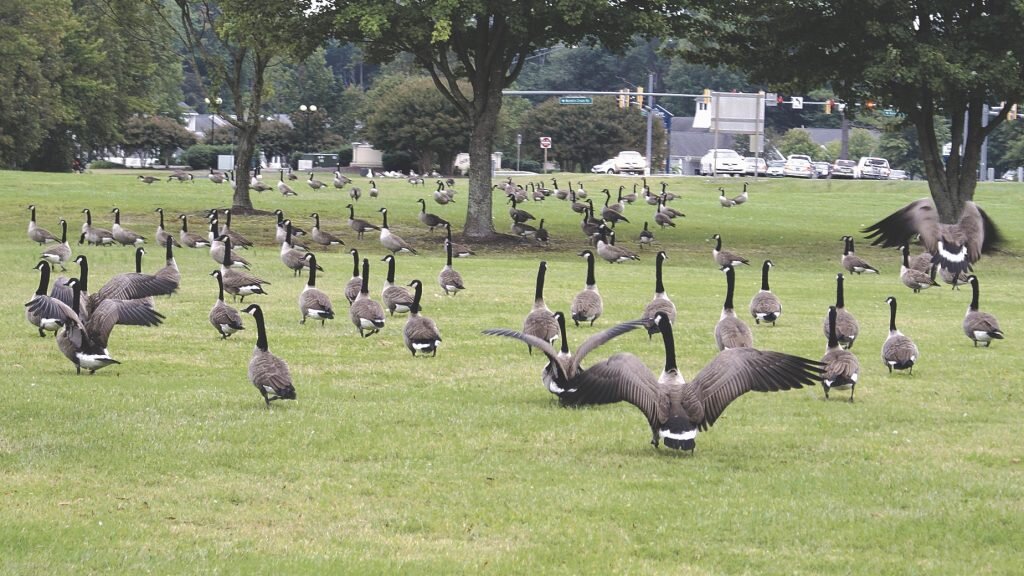
FILE PHOTO
Geese that once flocked to the Worcester County Veteran’s Memorial in Ocean Pines were recently removed through a program of the U.S. Department of Agriculture. The resident population was said to be too large and, as a result, damaging to the local environment.
By Brian Gilliland, Associate Editor
(July 19, 2018) While some considered Ocean Pines’ resident Canada goose population to be unofficial mascots, outside-only pets or a welcome sight upon returning home, experts said maintaining such a population can stress systems that people spent a long time in getting just right.
“The lawns, parks and golf courses we create makes ideal Canada goose habitat,” Josh Homyack, waterfowl program manager for the Maryland Department of Natural Resources, said. “When we insert those into areas with water access, that just makes it more inviting.”
Homyack said he didn’t believe those conditions developed together, but were just a coincidence that makes goose management a concern.
“I don’t think it happened on purpose, but a goose doesn’t know that,” Homyack said.
The addition of humans to an area often results in a decline in predators, making the area even safer for the geese.
Homyack said the geese were brought here about 100 years ago for hunting opportunities.
“They were also used as live decoys when that was allowed. When they got rid of that, the geese just stayed,” he said.
Goose populations were cultivated by humans for this purpose and spent generation after generation in relative captivity to the point where their migratory instincts just disappeared.
“A lot of people think these birds still migrate,” he said.
Genetically, Homyack said, these birds are a subspecies of the migratory ones and bring their own problems to the areas they claim as their home.
“Generally, problems arise when their numbers or density has increased in an area that is incompatible. These problems include: overgrazing of grass, ornamental plants and agricultural crops; accumulation of droppings and feathers; disease; attacks on humans by aggressive birds; and the fouling of reservoirs, swimming areas, docks, lawns and recreational areas,” Tanya Espinoza, public affairs specialist with the U.S. Department of Agriculture, animal and plant health inspection service, said.
Her department is responsible for the culling of the flock of 290 Canada geese from Ocean Pines at the end of June.
Nationally these geese, which Espinoza calls resident Canada geese, have increased in population from 230,000 in 1970 to 3.89 million in 2009, she said.
“The resident population in this area is too large,” she said. “When formulating management strategies, Wildlife Services specialists consider protected species, environmental impacts, the cost effectiveness of methods, and social and legal concerns. Management strategies may include the application of one or more techniques and consideration is first given to nonlethal methods.”
Espinoza provided necessary context to what is now being kept out of local waterways.
“Canada geese deposit one half to one full pound of feces per bird per day, which can significantly accumulate during molt season or on small properties with large flocks. In comparison, an average size dog drops about one half pound, which responsible owners clean up,” she said.
That’s almost 300 pounds of poo per day — more than one ton per week.
“The geese were humanely collected and euthanized, using methods approved by the American Veterinary Medical Association. The meat from the geese is processed and donated to local food pantries,” she said.
Espinoza did not elaborate on what method was used to euthanize the geese.
“The public can help and is encouraged to not feed waterfowl, including resident Canada geese. Although it can be entertaining to feed the geese and other animals, the food normally given is poor nutrition for geese and contributes to the conflicts that lead to removals such as this. High numbers of geese and easy access to food, including manicured lawns and handouts, often results in negative interactions between geese and people,” she said.
